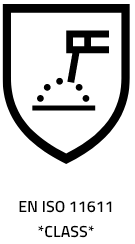EN ISO 11611
Protective clothing for use in welding and allied processes
EN ISO 11611 specifies minimum basic safety requirements and test methods for protective clothing including hoods, aprons, sleeves, and gaiters that are designed to protect the wearer’s body including head (hoods) and feet (gaiters) and that are to be worn during welding and allied processes with comparable risks. For the 
This type of protective clothing is intended to protect the wearer against spatter (small splashes of molten metal), short contact time with flame, radiant heat from an electric arc used for welding and allied processes, and minimizes the possibility of electrical shock by short-term, accidental contact with live electrical conductors at voltages up to approximately 100 V d. c. in normal conditions of welding. Sweat, soiling, or other contaminants can affect the level of protection provided against short-term accidental contact with live electric conductors at these voltages.
For adequate overall protection against the risks to which welders are likely to be exposed, personal protective equipment (PPE) covered by other International Standards should additionally be worn to protect the head, face, hands, and feet.
Classes
For all end-uses, the minimum performance requirement shall be at least one of the heat transmission performance code letters, i.e. code letter B, code letter C, code letter D, code letter E, or code letter F, in addition to the obligatory minimum performance requirements, code letter A. The application of the performance requirements of this Clause will be relevant according to the intended use claimed by the manufacturer for the clothing.
Class 1: Protection against less hazardous welding techniques and processes, causing lower levels of spatter and radiant heat
Class 2: Protection against more hazardous welding techniques and processes, causing higher levels of spatter and radiant heat











